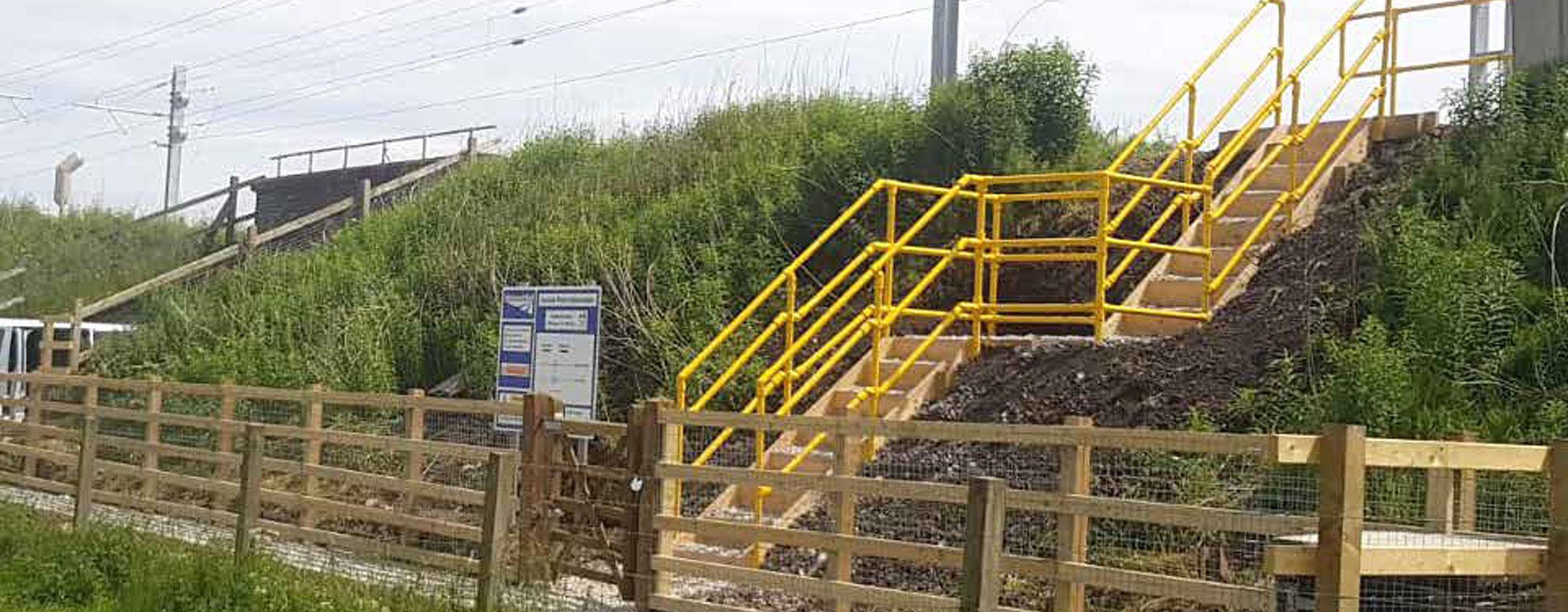To provide safe access to overhead line switching structures, Pod-Trak was contracted to install access stairs and walkways at various locations on North West Electrification Programme (NWEP) Phases 3 and 4.
As with any electrification project, safety is of paramount importance and creating a design which enabled safety while minimising any disruption during or after the works were completed were essential.
As the entire electrification project was new build, there was no existing access to any of the proposed new switching structures, so we were able to design a new access system from scratch.
The design included a series of walkways, steps, stairs and handrails.
The works were carried out on days and involved a lot of hand digging on embankments where it was unsuitable for machines.
This was a significant challenge that our team managed to overcome while sticking the timescales.
With tight timescales pre-commissioning, the works were planned for days to make use of longer working hours and improved conditions – while minimising any disruption to services as part of this programme.
Material load out took place on Saturday nights using on track plant to distribute materials to each location.
Excess spoil was then removed from site or spread locally dependant on location.
This project consisted of the construction of a new Signal Equipment Room (SER) base at Rickmansworth as part of the London Underground/TFL 4 Line Modernisation scheme in North West London.
The works form part of the wider London Underground 4LM (4 Line Modernisation) programme which involves complex infrastructure works, introduction of new trains and service changes.
Project Deliverables
Pod-Trak were awarded a package of works to construct a new Signal Equipment Room (SER) compound.
The overall Pod-Trak scope included:
- complex infrastructure works; new trains and service changes
- surveys and site clearance, including tree felling
- excavation and groundworks
- concrete base installation including large scale formwork and reinforcement
- retaining wall installation
- troughing and ducting works for electrical and earthing services
- drainage works including water control measures
- fencing installations
- new surface finishes to compound areas
- new access roads
With close collaboration between Pod-Trak, SSE and TfL, the civil engineering scope was completed and delivered one month ahead of the planned completion.
The project received a Beacon award from London Underground for its outstanding performance and commitment to excellent Health, Safety and Quality. This was a great reflection on how both the Pod-Trak and SSE team managed the site.
Pod-Trak was contracted to install 15km of cable containment throughout the North West Electrification Phase 4 project.
Initially the works were being delivered for Carillion who subsequently went into administration in January 2018. The project was stood down for a period of time and remaining scope delivered for Murphy.
The scope of works included raised GRP troughing, wall mounted tunnel & bridge containment and TTS ground laid route. All materials were free issue but called off, managed and distributed by Pod-Trak.
Most of the materials were delivered to site by RRV but in some instances this was not possible due to the volume of plant movements across the project. As such materials were loaded out by hand using track trolleys and additional manpower.
The majority of the scope was completed during short nighttime possessions which required a lot of planning and integration. This detailed planning of multiple teams was key to the delivery to meet programme dates for cable installation.
As part of the Railway Upgrade Plan, Network Rail are investing £170m for improvements across Upper Lea Valley between 2017 to 2019.
In this project, our work ensured that there was increased capacity on the line which reduces congestion for passengers and freight. In turn, this allows regeneration projects in the Upper Lea Valley area to run smoothly and, in turn, attract more people to live there. This line would make a difference to tens of thousands of people that use this route on a daily basis.
Project Deliverables
The upgrade entails 5.5km of new track which will allow an extra two trains per hour (during peak times) to run between Stratford and the new Meridian Water station, reducing congestion for passengers and supporting regeneration across the Upper Lea Valley area.
Pod-Trak undertook delivery of the civils aspect, this included:
- Reduced level dig
- Installation of 5.5km of a Primary Type 1 formation and structure transitions
- Removal and reinstatement of soft spots providing CBR, DIN and materials testing at 50 meter intervals
- Installation of perforated and carrier track drainage systems and deep surface water drainage systems
- 1 no. Drainage and 5 no. Utility UTX’s.
- Culvert strengthening works
- 750 meters of elevated and concrete trough works
- 5 no. Gravity OLE Bases
- 5.5km of bottom ballast installation utilising 2D Dozers
- Construction of 330 meters of reinforced earthworks bund which acted as a noise barrier
- Site wide hardscaping
Challenges and Solutions
The site was divided into 9 zones, each zone with a different site access date (design). Pod-Trak, in collaboration with the client, rescheduled and accelerated available works to ensure sectional completion and more importantly, continuity for the Permanent Way team. Production was increased, regardless of the high volume of soft spots encountered.
To mitigate this issue, we installed a geogrid combined with a PW1 Terram to achieve the required CBR at formation level, reducing the potential excavations by 50% and allowing works to proceed efficiently, meeting the key handover date.
The Felixstowe Capacity Enhancement Scheme was a £60m Project as part of Network Rail’s Upgrade Plan which was funded by the Strategic Freight Network and Hutchinson Ports to increase the freight capacity to and from the Port of Felixstowe.
This rail project was part of a wider project which is enhancing the lines around the Port of Felixstowe to improve capacity for freight in and around the area.
Working closely with our client, we produced efficient phasing and logistics plans to ensure successful, timely and safe delivery, achieving the key bottom ballast installation date on the 22nd of September 2018.
This earthworks project has seen the successful completion of 1.4km of new track formation including all ground stabilisation, drainage blankets and 800 metres of embankment.
Pod-Trak moved approximately 12,000 tonnes of excavated material off site and managed the importation of approximately 14,000 tonnes of aggregate via engineering trains to complete works up to bottom ballast level.
Works also included:
- The installation of 1.4km of cess walkway
- The application of 1,800m² of Maccaferri MacMat® R badger netting
- Several Twin Track UTXs
Challenges and Solutions
The loss of the site haul road due to third party restrictions, introduced an unplanned logistic risk that further constrained the site and introduced nonsequential working. To mitigate, Pod-Trak and VolkerFitzpatrick introduced a temporary RRAP at Gun Lane to import fill material and extract spoil under line blocks.
This was further supported by well-planned traffic staging and excellent implementation by all parties.
Pod-Trak was contracted to carry out all the civils modifications within the depot that were necessary to facilitate the maintenance and use of bi-mode trains being used on the Great Western Main Line.
The scope of works included construction of a haul road, depot wide UTX’s, drainage, walkways, HV cable routes, concrete bases and three substation bases. The work area was provided in stages with four roads being available for use at each stage of the programme. All works were carried out during midweek days and with careful planning the depot remained operational at all times.
The construction of the UTX’s proved challenging due to the depth of the trench and the size of the turning chambers. Deep excavations with poor ground conditions throughout the depot posed a constant challenge to the project team.
Temporary works design and controls were key to making sure our teams and others within the depot were not put in any danger during the construction phase.
Works were facilitated by the use of in-house on track plant to move materials through the depot on a daily basis.

